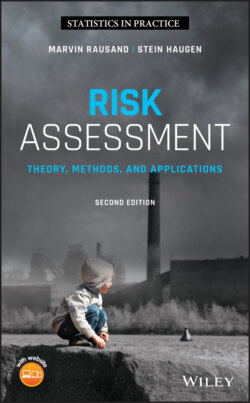Читать книгу Risk Assessment - Marvin Rausand - Страница 43
Example 2.2 (Accident scenario involving more than one hazard)
ОглавлениеA possible accident scenario may comprise the following events:
1 (a) A car driver loses control over her car on a road.
2 (b) The car moves over in the opposite lane.
3 (c) A truck coming in the opposite direction tries to avoid collision and swerves off the road.
4 (d) The truck topples over.
5 (e) The truck carries petrol that is spilled.
6 (f) The petrol ignites, causing a large fire.
In this case, several hazards can be identified: The speed (kinetic energy) of the first car, the speed of the truck, and the petrol in the truck.
The term “hazard” is widely used in many different ways in connection with risk assessment. The systematic methods that we use to answer the question “what can go wrong?” are often called “hazard identification methods,” even if it is initiating events or hazardous events that are identified.
Many hazards are related to energy defined in a very wide sense. Examples are mechanical, thermal, or electrical energy. Table 2.3 lists some hazards together with brief comments, to further illustrate the definition of hazard.
Table 2.3 Examples of hazards.
| Hazard | Comment |
| A car | A stationary car can be a hazard if it is located on top of a hill (in a specific state) and can start rolling (releasing potential energy). It is also a hazard because it contains fuel that represents thermal energy (a property of the material) that can ignite or explode. There is also electrical energy stored in the battery. A moving car represents an additional hazard because it has kinetic energy. |
| Propane gas under pressure | In this case, both the state (under pressure) and a property (flammable) represent hazards associated with the propane. |
| Water in a hydroelectric power dam | It is the water that is stored that is the main hazard in this case. The water contains massive amounts of potential energy and if the water is released this may cause severe damage. The dam itself can also be regarded as a hazard, but then just locally, because it can collapse and kill people nearby or damage equipment. |
| Ammunition for a gun | According to the definition, it is the gunpowder that is the hazard. It is the thermal energy in the gunpowder that makes it expand rapidly and fire the bullet. Pulling the trigger on a gun that is loaded is the initiating event that releases the energy. |
| A large crowd in a confined space | A full football stadium can be seen as a hazard. Some unexpected event can lead to panic and trigger rapid evacuation. This is a situation that can cause injuries and even fatalities. |
| Tension between tectonic plates | It may seem strange to define this and not earthquake as a hazard, but the earthquake is the event that follows from release of the energy that is otherwise under control (at least temporarily). |
| Pressure differences in the atmosphere | This is also an unusual definition and in most cases storm would be seen as the hazard. Similarly to earthquake, storm is the event that results from the pressure difference. |
| Tension in an offshore structure | The initiating event in this case could be “structural collapse,” caused by the tension in the structure exceeding the load‐bearing capacity. |
Some of these hazards may seem counterintuitive and needlessly formal. In practice, the term “hazard” is used in many different ways and often without any clear definition. We come back to this issue in later chapters.
